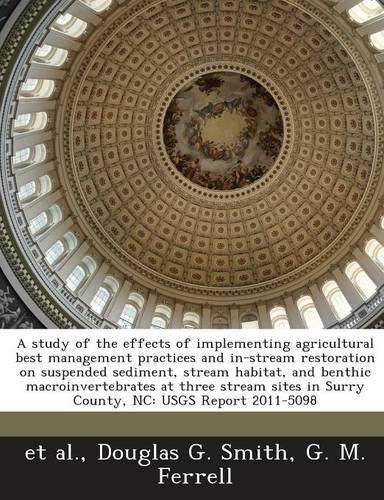Readings Newsletter
Become a Readings Member to make your shopping experience even easier.
Sign in or sign up for free!
You’re not far away from qualifying for FREE standard shipping within Australia
You’ve qualified for FREE standard shipping within Australia
The cart is loading…






The effects of agricultural best management practices and in-stream restoration on suspended-sediment concentrations, stream habitat, and benthic macroinvertebrate assemblages were examined in a comparative study of three small, rural stream basins in the Piedmont and Blue Ridge Physiographic Provinces of North Carolina and Virginia between 2004 and 2007. The study was designed to assess changes in stream quality associated with stream-improvement efforts at two sites in comparison to a control site (Hogan Creek), for which no improvements were planned. In the drainage basin of one of the stream-improvement sites (Bull Creek), several agricultural best management practices, primarily designed to limit cattle access to streams, were implemented during this study. In the drainage basin of the second stream-improvement site (Pauls Creek), a 1,600-foot reach of the stream channel was restored and several agricultural best management practices were implemented. Streamflow conditions in the vicinity of the study area were similar to or less than the long-term annual mean streamflows during the study. Precipitation during the study period also was less than normal, and the geographic distribution of precipitation indicated drier conditions in the southern part of the study area than in the northern part. Dry conditions during much of the study limited opportunities for acquiring high-flow sediment samples and streamflow measurements.
$9.00 standard shipping within Australia
FREE standard shipping within Australia for orders over $100.00
Express & International shipping calculated at checkout
The effects of agricultural best management practices and in-stream restoration on suspended-sediment concentrations, stream habitat, and benthic macroinvertebrate assemblages were examined in a comparative study of three small, rural stream basins in the Piedmont and Blue Ridge Physiographic Provinces of North Carolina and Virginia between 2004 and 2007. The study was designed to assess changes in stream quality associated with stream-improvement efforts at two sites in comparison to a control site (Hogan Creek), for which no improvements were planned. In the drainage basin of one of the stream-improvement sites (Bull Creek), several agricultural best management practices, primarily designed to limit cattle access to streams, were implemented during this study. In the drainage basin of the second stream-improvement site (Pauls Creek), a 1,600-foot reach of the stream channel was restored and several agricultural best management practices were implemented. Streamflow conditions in the vicinity of the study area were similar to or less than the long-term annual mean streamflows during the study. Precipitation during the study period also was less than normal, and the geographic distribution of precipitation indicated drier conditions in the southern part of the study area than in the northern part. Dry conditions during much of the study limited opportunities for acquiring high-flow sediment samples and streamflow measurements.